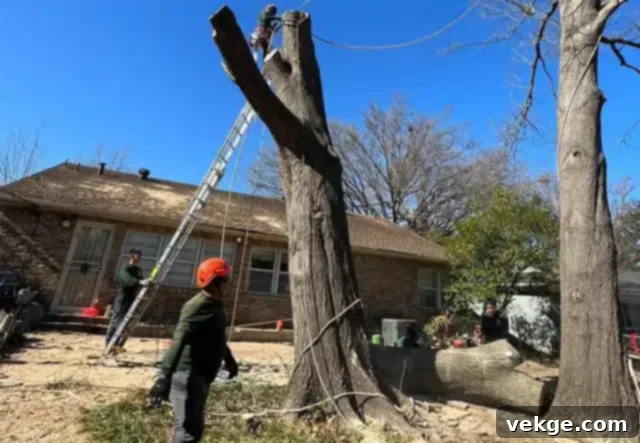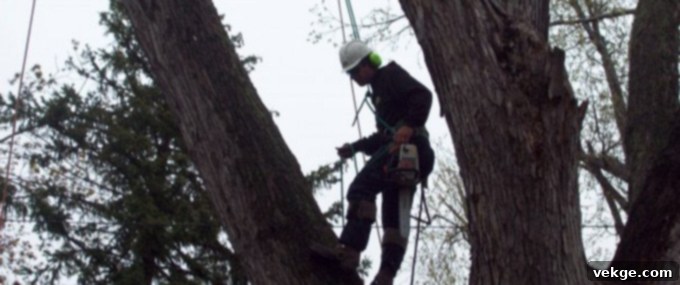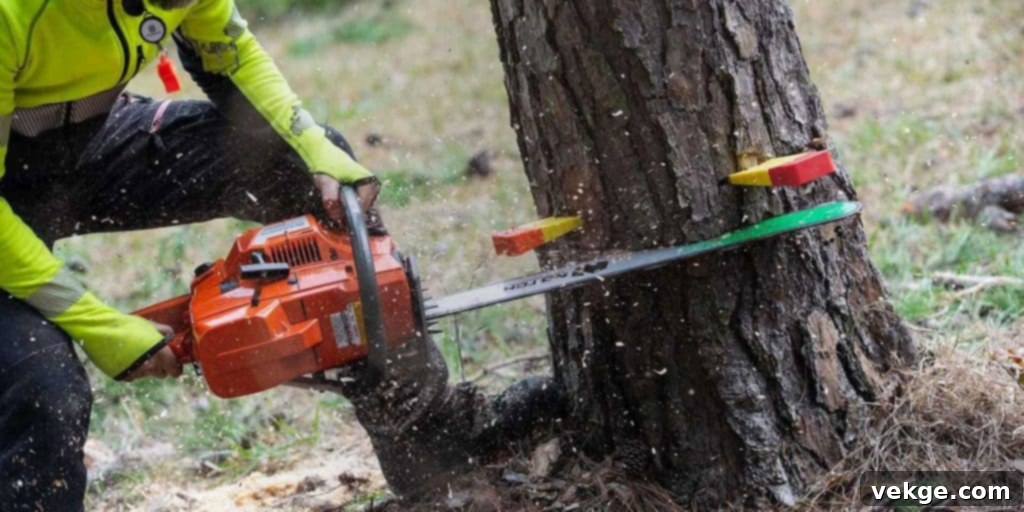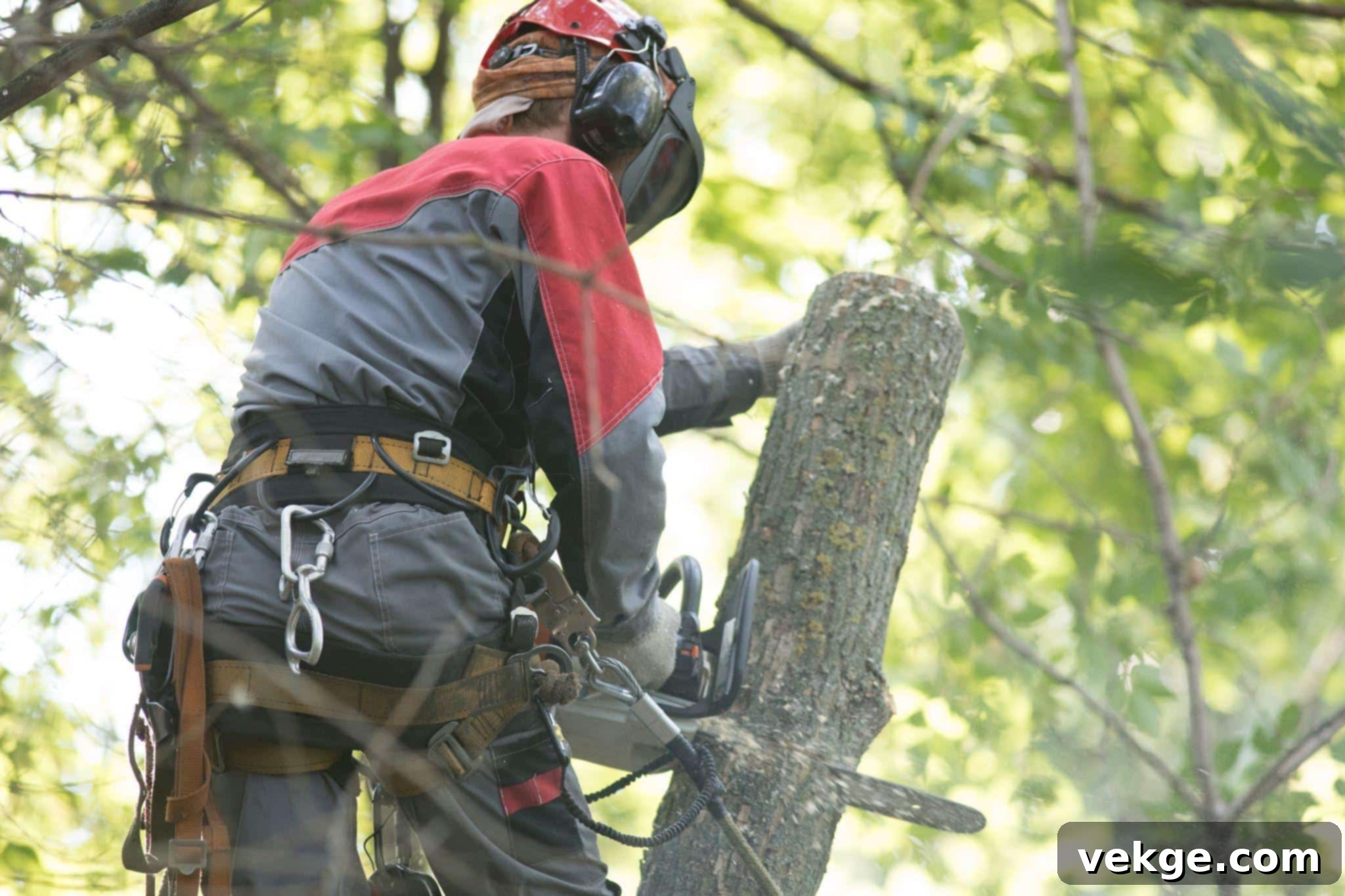The Ultimate Guide to Safe Tree Removal: Protecting Property, People, and the Planet
Tree removal is a task far more complex and demanding than it often appears. While it fundamentally involves the felling of a tree, the intricacies of the process extend significantly beyond that single action. It demands meticulous planning, an expertly crafted execution strategy, and, critically, the stringent application of safety measures at every stage. Attempting to cut down a tree without a thorough consideration of safety protocols can lead to substantial risks, potentially jeopardizing the health and well-being of individuals involved, causing significant damage to surrounding property, and even resulting in severe environmental harm or legal complications. This comprehensive article delves into why prioritizing safe techniques is not just advisable but absolutely crucial during any tree removal operation, whether it’s a small backyard project or a large-scale commercial undertaking.
The Grave Risks Involved with Inefficient Tree Removal
Tree removal, when handled inefficiently or carelessly, is fraught with considerable dangers. Accidents are unfortunately common in this field, and they can result in severe injuries that may have profound and long-lasting impacts on a person’s well-being. The sheer force of gravity combined with heavy, sharp equipment creates a high-risk environment. Falling branches, misjudged cuts, improper use of chainsaws, and the mishandling of rigging equipment are just a few common scenarios where things can go terribly wrong. These injuries can range from minor cuts, abrasions, and sprains to severe cases requiring extensive medical intervention, such as broken bones, head trauma, spinal injuries, or even fatalities.

Beyond personal harm, inefficient or haphazard tree removal procedures can lead to considerable and often costly damage to property. It’s easy to underestimate the immense weight and unpredictable trajectory of a falling tree or its branches, leading to unexpected destruction. This can include damage to residential structures like roofs, walls, and foundations, as well as to fences, vehicles, landscaping, and critical utility lines such as power, phone, or internet cables. The financial repercussions of such property damage can be massive, involving expensive repairs, insurance deductibles, and the inconvenience of property downtime, creating an immense additional burden for property owners.
The legal consequences associated with improper tree removal are also significant and should not be overlooked. Engaging in illegal tree cutting, especially when it involves protected species, trees within conservation areas, or disputes regarding boundary trees with neighbors, can lead to severe repercussions. Property owners or individuals performing the removal could face substantial lawsuits, hefty fines, criminal charges, or other serious legal penalties. Additionally, negligence leading to injury or property damage can result in liability claims, further compounding the financial and emotional stress. Adhering to local regulations and obtaining necessary permits are crucial steps in avoiding these legal pitfalls.
Furthermore, unsafe practices can cause significant harm to the environment. Uncontrolled felling can damage surrounding vegetation, compact soil, disrupt local ecosystems, and even harm wildlife habitats. Proper disposal of tree waste is also an environmental consideration. A safe and responsible tree removal process minimizes ecological disturbance, ensuring that the local environment is respected and preserved as much as possible.
Understanding the Core Basics of Safe Tree Removal
The foundation of truly safe tree removal lies in a multi-faceted approach, beginning with having the correct, high-quality tools and equipment. These tools are specifically designed to handle heavy-duty tasks with precision and power. Essential equipment includes various types of chainsaws (appropriate for the tree size), stump grinders for complete removal, wood chippers for debris management, and specialized rigging equipment such as ropes, pulleys, and winches for controlled descent. It’s imperative to understand that each piece of equipment has a specific function and must be maintained, calibrated, and used correctly according to manufacturer guidelines to ensure maximum safety and operational efficiency.

In addition to proper tools, wearing appropriate Personal Protective Equipment (PPE) is an absolutely critical aspect of safety during tree removal. This includes robust helmets designed to protect against falling objects, safety goggles or face shields to guard against flying debris, heavy-duty gloves for grip and protection, hearing protection to prevent noise-induced damage from chainsaws, and steel-toed safety boots for foot protection. Crucially, chainsaw protective chaps or trousers are vital to protect against kickback or accidental contact with the saw chain. This gear forms the last line of defense against potential injuries.
A meticulous pre-removal assessment is another pivotal step in guaranteeing safety and efficiency. This involves a comprehensive evaluation of the tree itself and its surrounding environment. Key aspects include identifying potential hazards within the tree (such as dead or decaying branches, insect infestations, bee hives, or nests), assessing the tree’s overall health and structural integrity (looking for signs of disease or decay), predicting the tree’s natural lean and potential fall path, and evaluating the presence of nearby obstacles like power lines, buildings, fences, or underground utilities. Preparing for any unforeseen circumstances, such as changes in wind direction, is also part of this crucial planning phase.
Crucial to tree removal safety is a deep understanding of tree growth and removal insights. Being aware of the characteristics of various tree types, understanding their unique growth patterns, recognizing signs of specific tree diseases, and knowing how different species react to cutting can significantly aid in planning the removal process effectively and safely. This specialized knowledge allows for informed decisions about cutting techniques, rigging strategies, and disposal methods.
Finally, undertaking formal training and gaining practical experience in tree removal are instrumental in enhancing safety and proficiency. These aspects equip individuals with the necessary skills to accurately identify risks, plan the job meticulously, operate complex machinery safely, and execute the removal process with precision. Professional certifications, such as those from the International Society of Arboriculture (ISA), demonstrate a commitment to safety and best practices in arboriculture.
The Multifaceted Benefits of Prioritizing Safety in Tree Removal
The advantages of rigorously prioritizing safety in all tree removal practices are numerous and far-reaching. A primary and undeniable benefit is, of course, the prevention of harm to people and the averting of property damage. A safe, well-planned, and expertly executed tree removal operation significantly minimizes the chances of accidents, thereby protecting both the person operating the equipment, other workers, and any bystanders. This commitment to safety fosters a secure working environment and provides invaluable peace of mind for everyone involved, especially the property owner.

Beyond the clear physical benefits, prioritizing safety also makes profound financial sense in the long run. By proactively avoiding unintended property damages, preventing costly medical emergencies and associated healthcare costs, and circumventing potential legal charges or insurance claims, robust safety measures prove to be a highly cost-effective strategy. The upfront investment in proper equipment, training, or professional services is invariably less than the expenses incurred from an accident, lawsuit, or extensive property repairs. It’s an investment in risk mitigation that pays dividends.
Furthermore, compliance with local governing laws and municipal ordinances is significantly enhanced when safety is a top priority. This circumvents legal disputes, hefty fines, and other penalties that can arise from unauthorized, improperly permitted, or unsafe tree cutting practices. Safety measures ensure that all aspects of tree removal, from planning to execution and waste disposal, adhere strictly to legislative requirements, promoting full regulatory compliance and protecting the property owner from legal liabilities.
Moreover, prioritizing safety also plays a crucial role in preserving the environment and protecting surrounding trees and plant life from unintended damage. As tree removal can inadvertently disrupt local fauna and flora, a carefully planned and safely executed removal process mitigates these potential environmental impacts. This includes carefully directing the fall of the tree to avoid impacting other healthy vegetation, minimizing soil disturbance, and ensuring that removed organic material is disposed of responsibly, perhaps through chipping for mulch or composting, thus contributing to environmental sustainability.
Essential Safety Techniques in Tree Removal: A Deeper Dive
Safe removal techniques truly begin long before the actual cutting down of a tree. The initial steps are critical for setting up a secure operation. This includes a thorough assessment of the tree’s stability and structural integrity, a detailed evaluation of the working area to identify potential hazards and clear the fall zone, understanding the tree’s natural lean and weight distribution, and conducting a complete risk assessment that considers wind conditions, power lines, and nearby structures. Establishing a safe perimeter and communicating clearly with any ground crew or bystanders are also vital initial steps.

When it comes to the actual felling, proper cutting techniques are paramount. This includes a deep understanding of how to create appropriate directional felling notches (such as a Humboldt or open-face notch) and a controlled hinge that guides the tree’s fall precisely where intended. Mastery of the back-cut procedure and the use of felling wedges to control the direction and speed of the fall significantly contribute to a safe and efficient tree removal process. For large, complex, or compromised trees, sectional removal is often the safest method, where branches and sections of the trunk are carefully lowered to the ground in a controlled manner.
For such large trees or those in confined spaces, using ropes, specialized rigging pulley systems, or even cranes can dramatically improve safety by providing superior control over the tree’s movement. These advanced techniques allow arborists to remove sections of the tree piece by piece, preventing uncontrolled falling and minimizing the risk of damage to property or injury to personnel. This precision is especially crucial in urban or suburban environments where space is limited.
Dealing with power lines and other potential obstacles requires extreme caution and meticulous planning. Identifying such possible threats beforehand is an absolute necessity. If a tree or any part of it is near power lines, it is essential to contact the local utility company immediately. They can temporarily shut off power or send a specialized crew to manage the situation safely. Never attempt to remove a tree near active power lines yourself. Taking appropriate measures to mitigate all identified risks, from structural proximity to underground utilities, is an essential part of a truly safe tree removal process.
Hiring Professional Tree Removal Services: The Safest Option
If the complexities, risks, and extensive requirements for safe tree removal seem daunting – and for most property owners, they should – then hiring a professional tree removal service is undoubtedly the safest, most viable, and often most cost-effective option. Tree removal professionals, specifically ISA Certified Arborists, possess the unparalleled experience, specialized skill set, advanced equipment, and in-depth understanding necessary for executing safe and efficient tree removal. They are trained to navigate the unique challenges each tree presents, accurately assess all potential risks, and develop the most effective and safest action plan for removal.
Furthermore, reputable professional tree removal companies typically carry comprehensive insurance coverage. This includes general liability insurance, which offers financial protection against any unexpected property damages, and worker’s compensation insurance, which covers their employees in case of injury on the job. This critical layer of protection shields property owners from potential financial liabilities that could arise from an accident, providing invaluable peace of mind. Without this insurance, homeowners could be held personally responsible for damages or injuries.
When considering hiring a professional tree removal service, it is paramount to scrutinize several factors to ensure you are selecting a dependable and qualified choice. Look for companies with an excellent reputation, demonstrated by positive reviews and strong references. Verify their qualifications, such as ISA certification for arborists, and confirm they are properly licensed and bonded in your area. Always request a detailed written estimate and, crucially, verify their insurance certificates directly with the insurance provider. These due diligence steps ensure you are entrusting your tree removal to a competent and responsible professional.
Conclusion: Safety as the Cornerstone of Tree Removal
From the extensive discussion above, it becomes undeniably clear that the importance of prioritizing safe techniques in tree removal cannot be overstated. Primarily, it serves to protect individuals and property from potential harm, makes sound financial sense in the long run by preventing costly accidents, and ensures full regulatory compliance with local laws and environmental guidelines. Moreover, a commitment to safety demonstrates due consideration for the delicate environment, conserving surrounding trees, local habitats, and the overall ecological balance.
While a person might be tempted to undertake tree removal on their own to save some money, the inherent risks involved are substantial and often underestimated. Given the profound potential repercussions of unsafe tree removal techniques – including severe injuries, extensive property damage, significant legal issues, and environmental degradation – utilizing professional, insured, and certified tree removal services emerges as the most sensible, responsible, and indeed, the safest choice for homeowners and property managers alike.
In conclusion, safety, encompassing all its critical aspects, must remain at the absolute core of any tree removal task. The potential implications of unsafe methods are simply too damaging and far-reaching to be ignored or taken lightly. It’s not merely about the tree; it is about valuing human life, safeguarding valuable property, and preserving our precious natural environment for future generations.
In this critical context, arming oneself with the right knowledge and securing professional help can go an immeasurable distance in ensuring a safe, efficient, and responsible tree removal process. Choosing safety is choosing peace of mind, protection, and professionalism.
